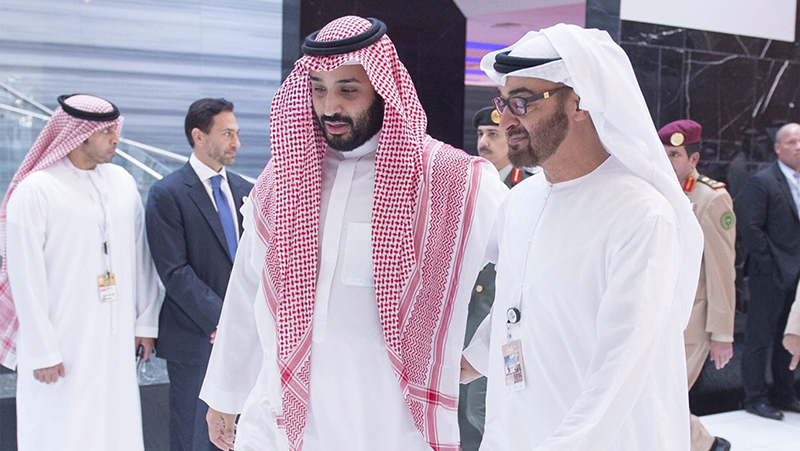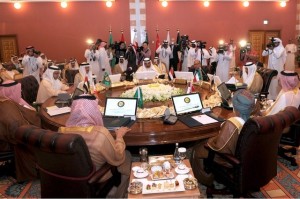by Charles W. Dunne
As recently as last June, the de facto alliance between Saudi Arabia, the United Arab Emirates, and Egypt appeared to be in the driver’s seat of US policy on the Middle East, influencing Trump Administration thinking on issues such as the boycott of Qatar, political turmoil in Sudan, and civil war in Libya. Despite mounting congressional and public opposition to the devastating Saudi and Emirati military campaign in Yemen, now in its fifth year, the administration vetoed attempts to suspend arms sales to Saudi Arabia and the UAE and continued to support them politically in their fight against Yemen’s Iran-backed Houthi rebels. Prominent foreign policy analysts in Washington argued that the surest way to bring the bloody conflict to an end was for the United States to double down on its support for the Saudi intervention.
But since then, small cracks in the Saudi-Emirati alliance have become larger fractures that have called into question the bonds of solidarity between Saudi Arabia and the United Arab Emirates, two of the Arabian Peninsula’s political and military heavyweights. Most prominently, the UAE’s backing of a southern separatist movement against the government of Yemeni President Abdrabbuh Mansour Hadi––whose authority the Emiratis had been trying to restore in partnership with the Saudis since his overthrow by the Houthis in 2015––has dealt a serious blow to the Saudi-led campaign. The current mess has increased the confusion in Washington’s Gulf strategy, complicating its Iran policy. In addition to forcing changes in the Trump Administration’s approach to Yemen, it may also affect the standing of both Saudi Arabia and the UAE in the American capital.
Khashoggi and Yemen Taking a Toll on Gulf Unity
Linkages between Saudi Arabia and the UAE have been under some stress for several reasons at least since October of 2018, when the US-based Saudi journalist Jamal Khashoggi was murdered in the Saudi consulate in Istanbul, Turkey. While publicly backing Saudi Crown Prince Mohammed bin Salman (MbS), who is widely thought to have ordered the murder, UAE leaders appear to have developed second thoughts concerning the wisdom of their close association with his leadership and policies. Once content to ride Saudi coattails to influence in Washington, leveraging the close relationship between MbS and Abu Dhabi Crown Prince and UAE de facto ruler Mohammed bin Zayed (MbZ), UAE leaders began to worry that their own reputation could be dragged through the mud as Saudi stock fell in Washington. Consequently, they have quietly begun to distance themselves from MbS and his regime.
The Yemen war, however, proved to be a more significant stressor of the relationship. Despite Abu Dhabi’s movement in apparent lockstep with Riyadh militarily and diplomatically, after the Saudi-led intervention began in 2015 on behalf of the internationally recognized Hadi government, it has become apparent over the last 18 months or so that, in reality, Saudi and Emirati interests in Yemen were never identical.
Saudi Arabia has always viewed the conflict through the prism of its struggle with Iran for regional supremacy, seeing Tehran’s backing for the Houthi rebels as a major security threat and as part of a strategy to establish a zone of influence and hostile intent along its southern border. As a result, the Saudis prosecuted the war as another front in the perceived existential struggle between the two countries, applying scorched-earth tactics in Yemen that took a heavy toll on the civilian population and infrastructure, producing a massive humanitarian crisis and possibly implicating the United States and other arms suppliers in war crimes, according to a UN experts report issued September 3.
The Emiratis, however, saw things rather differently. Inclined by economic realities and geopolitical proximity to take a more practical line toward Tehran, the UAE proved less interested in imposing a defeat on Iran and its Houthi allies than in achieving certain limited gains. Specifically, Abu Dhabi wanted to prevent the southern port of Aden from falling under the sway of Houthi forces and thereby imperiling shipping lanes through Bab al-Mandab, upon which Emirati interests depended heavily.
The disconnect simmered largely out of sight until the second week of August, when forces loyal to the UAE-backed Southern Transitional Council (STC), a political movement that advocates southern independence from the central government in Sanaa, moved to seize the port city of Aden, the capital-in-exile of the Hadi government. The move set off a fresh round of political and military chaos that posed a sharp new threat to the viability of the Yemeni state, prompting the Hadi government to call for the UAE’s expulsion from the coalition.
The seizure of Aden was all the more painful for the Saudi leadership in light of the fact that the UAE had ordered an abrupt drawdown of its forces from Yemen in July in favor of a more “diplomatic” approach. This perhaps reflected the growing sense in Abu Dhabi that the aim of restoring the Hadi government was not only increasingly unrealistic but also unimportant, if the UAE’s maritime interests could be secured through the agency of the STC. Word of the drawdown caused consternation in Riyadh and dealt a heavy blow to the coalition’s ability to prosecute the campaign against the Houthis.
Events took a much more serious turn on August 29 when the Hadi government blamed the UAE for bombing its forces in Aden and Zinjibar, a coastal city 34 miles to the northeast, and called on Saudi Arabia to “stop this illegal and unjustified military escalation.” (The UAE admitted the attacks but claimedit was targeting “terrorists,” not government troops.) Together, these developments highlighted the sense of a serious—and perhaps irreparable—split between the two allies on the ground.
US Changing Course on Yemen, with Iran on Its Mind
These events prompted Washington to take a fresh look at its policies and its friends in the Gulf, and some changes with regard to both seem to be in store.
In response to developments in Aden, the State Department issued a statement noting that it was “deeply concerned” by the violence and calling for “dialogue” to resolve differences among the warring parties. But little else in the nature of high-level US diplomacy to patch up Saudi-UAE differences has been in evidence. In fact, reports recently emerged that the Trump Administration, which has up to now fully backed the Saudis and their Yemen campaign, has decided to open direct talks with the Houthis in Oman and is urging Riyadh to come to the table as well.
The reason for this startling shift is most likely the administration’s concern about how the deteriorating situation in Yemen might affect its policy toward Iran—a far more important consideration for the White House than anything taking place in Yemen itself.
Washington’s strategy of “maximum pressure” on Tehran, coupled with the recent deployment of additional military assets to the Gulf and high-stakes rhetorical volleys levied at Iran’s leaders, have raised the possibility of a military clash, which could be unpredictable in scope and consequences. Recent sub-rosa Israeli military strikes against Iran-allied forces in Lebanon, Syria, and Iraq have increased the risk that US forces in the region could be the target of retaliatory attacks. Under these circumstances, the administration appears concerned that the worsening military situation and the collapse of Saudi-UAE unity on the ground in Yemen presents the prospect of an increasingly unwinnable war that, at the very least, would prove to be a damaging distraction in the event of a confrontation among the United States, the Gulf states, and Iran. Indeed, the increasing pace and scopeof Houthi drone and missile attacks against Saudi oil and other economic infrastructure, despite having caused little serious damage so far, highlight the kingdom’s vulnerabilities in the event of increased tensions. This factor has probably influenced the administration’s change of course and may have helped persuade the White House to try to convince, or compel, the Saudis to join the talks with the Houthis.
The administration’s new tack on Yemen may prove to be well timed. With the apparent collapse of the Saudi-UAE alliance in Yemen, the White House will find it harder than ever to fend off pressure from congressional opponents of American military support for the Saudi campaign in Yemen, and new legislative efforts to curb American support for the war are already underway. Congressional focus on Saudi Arabia is intensifying; Senate Foreign Relations Committee Chairman James E. Risch (R-Idaho) has introduced the Saudi Arabia Diplomatic Review Act of 2019, which would mandate a comprehensive review of US policy toward Saudi Arabia as well as its actions in Yemen and record on human rights. Risch told The Washington Post that he believes President Donald Trump might be amenable to the legislation.
Wider Concerns: MESA, Counterterrorism
The fallout from Yemen could affect broader US regional strategy as well. For one thing, plans for a new Middle East Strategic Alliance (MESA) to counter regional threats (mainly Iran) are likely to be jeopardized further. Announced in May 2017, construction of the new security architecture depends to a great extent on the preservation of political-military unity among the Gulf Arab states, who would contribute basing and funding and bring their most modern weapons systems to the effort. Current Saudi-Emirati tensions—combined with Egypt’s pullout from the proposed alliance in April, the ongoing Saudi-led boycott of Qatar, and preexisting Gulf reluctance to increased military integration—make such unity more tenuous than ever. While grand plans for standing up regional military alliances and/or enhanced multinational security cooperation have come and gone over the years, MESA was to have been the cornerstone of the administration’s regional security policy.
The disputes among allies in the Yemen war may threaten other important US interests as well, particularly the fight to eliminate al-Qaeda elements in Yemen. The United States became militarily involved in the country during the Bush administration’s Global War on Terror; under Obama and then Trump, the long-term battle against al-Qaeda in Yemen became an important factor in determining US support for Saudi Arabia and the UAE. Despite some significant tactical successes against the terrorist group, diversions of US arms to al-Qaeda elements by Riyadh and Abu Dhabi undermined American goals; the rupture between the allies now seems likely to degrade the anti-terrorism campaign further, providing new political and geographical space for AQ and other terrorist groups to operate.
Finally, Trump Administration strategy in the Middle East has been predicated to an unusual degree on the president’s personal relationships with key autocrats of the Gulf and Egypt––in addition to Israel—to deliver a unified front on Iran, counterterrorism, combatting political extremism, and providing support for presidential son-in-law Jared Kushner’s long-delayed Palestinian-Israeli peace plan. With the rift among Gulf powers widening, the president may find it significantly harder to deliver success on any of these fronts as next year’s presidential election looms.
Alienation of Affection
Where could this lead next? It is possible, though not immediately likely, that the recent developments in Yemen will effect a shift in the administration’s Gulf policy, or at least the way President Trump regards his current princely allies. If the president came to view the latest Yemen fiasco as a sign that Saudi Crown Prince Mohammed bin Salman can no longer deliver or even keep his own coalition partners in line, thus negatively impacting his own top priorities in the Gulf, the president might decide that it is time to reevaluate his relationship with MbS. The close relationship with the Emiratis could be up for readjustment as well; having caused some heartburn in Washington by apparently backing away from the administration’s hard-line Iran policy, and complicating matters with its behavior in Yemen, the UAE—and its standing—and the Abu Dhabi crown prince might take a hit with President Trump.
Alternatively, if the president were to reverse course suddenly and engineer a diplomatic opening with Tehran, something both he and the Iranians appear to be open to, but the Saudis and Emiratis are, emphatically, not—that could also strain relations with Riyadh and Abu Dhabi.
Either outcome is possible, given the volatility of the situation in the Gulf (of which the Yemen debacle is the most recent illustration) and the mercurial nature of President Trump. And if either of those things happens—though there is no sign just now that they will—foreign relations in the Gulf could be in for a drastic shakeup indeed.
Charles Dunne is a Non-resident Fellow at Arab Center Washington DC. To learn more about him and read his previous publications click here. Republished, with permission, from the Arab Center.






Another wonderful article by the ‘arab center’ that is paid for and directed by our friends in the Gulf. If Saudi Arabia went to war in Yemen because they thought the Houthies are back by Iran, they have very poor advisors and leaders. For a minimal fraction of the money SA spend in Yemen trying to kill the Houthies, they could buy their army. Even, for a fraction of the funds they provide to think tanks such the ‘arab center’ or Harvard, SA could have Yemen be their vassal state. The point here is that SA wants to show how strong they are and thought that by bullying Yemen they could make a great statement. Unfortunately that was not the case and everyone now suffers for just egotistical reasons.